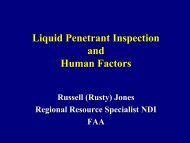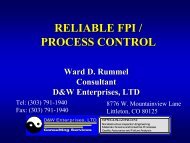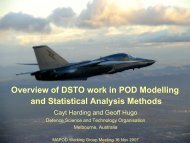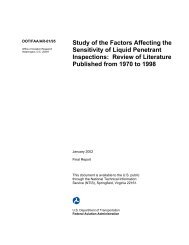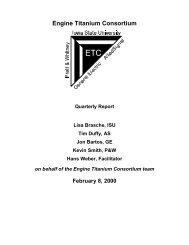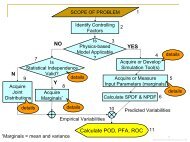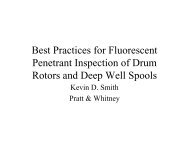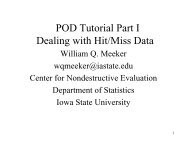Engine Titanium Consortium - Center for Nondestructive Evaluation ...
Engine Titanium Consortium - Center for Nondestructive Evaluation ...
Engine Titanium Consortium - Center for Nondestructive Evaluation ...
Create successful ePaper yourself
Turn your PDF publications into a flip-book with our unique Google optimized e-Paper software.
Project 1:<br />
Task 1.1:<br />
Subtask 1.1.1:<br />
Production Inspection<br />
Nickel-based Alloy Inspection<br />
Fundamental Property<br />
Measurements <strong>for</strong> Nickel Billet<br />
Team Members:<br />
HW: Andy Kinney, Waled Hassan<br />
ISU: Frank Margetan, Bruce Thompson,<br />
Ron Roberts<br />
GE: Ed Nieters, Mike Gigliotti, Lee<br />
Perocchi, Jon Bartos, Mike Keller, Richard<br />
Klaassen, John Halase, Dave Copley<br />
PW: Jeff Umbach, Bob Goodwin, Andrei<br />
Degtyar, Harpreet Wasan<br />
Students: L. Yu<br />
Program initiation date: June 15, 1999<br />
Objectives:<br />
• To establish the basic ultrasonic properties of nickel-based alloy billet materials (Expected to be<br />
IN718, and one or more of Waspaloy, IN901, R95, or IN100) and relevant inclusions as an<br />
appropriate foundation <strong>for</strong> selection of ultrasonic inspection approaches.<br />
• To manufacture and characterize flat bottom hole (FBH), synthetic inclusion, and real defect<br />
standards to provide data <strong>for</strong> determining defect detectability and developing improved<br />
inspections.<br />
• To improve the understanding of the relationship of defect size, shape, and composition on<br />
defect detectability in Ni alloys.<br />
Approach:<br />
Alloy Selection: Several alloys have been selected <strong>for</strong> fundamental property measurements with<br />
IN718 selected to receive the primary focus. Alloys to be considered include Waspaloy, IN100,<br />
IN901, and R95. Sample design and fabrication <strong>for</strong> properties measurements will be initiated by<br />
the team members. A list of the types of melt-related defects encountered at the billet stage in<br />
Ni-based alloys, defect morphology in the <strong>for</strong>ged condition, and importance to life management will<br />
be generated by RISC. The importance of defect parameters (size, concentration, morphology,<br />
presence of voids) on detectability and life will be determined through discussion with the lifing and<br />
materials communities.<br />
Sample Fabrication: The sequence of manufacturing the properties specimens and the specimen<br />
configuration will be planned to yield as much data as possible on properties as a function of depth<br />
and orientation. Novel configurations of coupons, and sequences of coupon extraction and<br />
characterization will be considered. Sample fabrication procedures will be coordinated with the<br />
Inspection Systems Capability Working Group to ensure use by both groups<br />
The proposed billet coupon scheme is shown in Figure 1. Because backscattered noise levels are<br />
strongly dependent on details of the metal microstructure, they can be used to guide the selection<br />
of coupon locations. From low and high noise regions, a "strip" specimen will be cut along the billet<br />
Quarterly Report – January 1, 2002 –March 31, 2002<br />
print date/time: 6/6/2002 - 8:39 AM – Page 2



